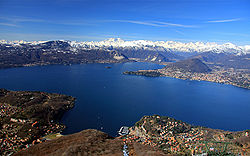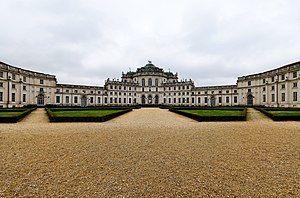Piedmont
|
|
show
You can help expand this article with text translated from the corresponding article in Italian. (March 2020) Click [show] for important translation instructions.
|
Piemont (Piedmontese)
Piemont (Occitan)
CountryCapitalGovernment • PresidentArea • TotalPopulation (31 January 2021) • Total • DensityDemonym(s)Time zone • Summer (DST)ISO 3166 codeGDP (nominal)GDP per capitaHDI (2021)NUTS RegionWebsite
|
Coat of arms
|
|
| Anthem: Inno di Piemonte 1:54
|
|
 |
|
| Coordinates: 45°04′N 7°42′E | |
| Italy : Country | |
| Turin Capital | |
| Alberto Cirio (FI) : President | |
| 25,402 km2 (9,808 sq mi) : Area | |
| 4,269,714 : Total Population (2021 January) | |
| 170/km2 (440/sq mi) : Density | |
| English: Piedmontese Italian: Piemontese |
|
| UTC+1 (CET) | |
| UTC+2 (CEST) | |
| IT-21 | |
| €137 billion (2018)[1] | |
| €31,500 (2018)[2] | |
| 0.901[3] very high · 10th of 21 |
|
| ITC1 | |
| www.regione.piemonte.it | |
Piedmont (/ˈpiːdmɒnt/ PEED-mont; Italian: Piemonte, pronounced [pjeˈmonte])[4] is a region of Northwest Italy, one of the 20 regions of Italy.[5] It borders the Liguria region to the south, the Lombardy and Emilia-Romagna regions to the east, and the Aosta Valley region to the northwest; it also borders Switzerland to the north and France to the west. It has an area of 25,402 km2 (9,808 sq mi) making it the second largest region of Italy after Sicily; as of 31 January 2021, the population was 4,269,714. The capital of Piedmont is Turin, which was also the capital of the Kingdom of Italy from 1861 to 1865.
Toponymy[edit]
The French Piedmont, the Italian Piemonte, and other variant cognates come from the medieval Latin Pedemontium or Pedemontis, i.e. ad pedem montium, meaning "at the foot of the mountains" (referring to the Alps), attested in documents from the end of the 12th century.[6]
Geography[edit]


Piedmont is surrounded on three sides by the Alps, including Monviso, where the river Po rises, and Monte Rosa. It borders with France (Auvergne-Rhône-Alpes and Provence-Alpes-Côte d'Azur), Switzerland (Ticino and Valais), and the Italian regions of Lombardy, Liguria, Aosta Valley, and for a very small part with Emilia Romagna. The geography of Piedmont is 43.3% mountainous, along with extensive areas of hills (30.3%) and plains (26.4%).
Piedmont is the second largest of Italy's 20 regions, after Sicily. It is broadly coincident with the upper part of the drainage basin of the river Po, which rises from the slopes of Monviso in the west of the region and is Italy's largest river. The Po drains the semicircle formed by the Alps and Apennines, which surround the region on three sides.
The countryside is very diverse: from the rugged peaks of the massifs of Monte Rosa and Gran Paradiso to the damp rice paddies of Vercelli and Novara, from the gentle hillsides of the Langhe, Roero, and Montferrat to the plains. 7.6% of the entire territory is considered protected area. There are 56 different national or regional parks; one of the most famous is the Gran Paradiso National Park, between Piedmont and the Aosta Valley.
Piedmont has a typically temperate climate, which on the Alps becomes progressively temperate-cold and colder as it climbs to altitude. In areas located at low altitudes, winters are relatively cold but not very rainy and often sunny, with the possibility of snowfall, sometimes abundant. Snowfall, on the other hand, is less frequent and occasional in the northeast areas. Summers are hot with local possibilities of strong thunderstorms.[7]
Major towns and cities[edit]
Population rankCity NamePopulation(ab)Surface(km2)Density(ab/km2)Altitude(m s.l.m.)Province ormetropolitan city
| 1 | Turin | 875,698 | 130.17 | 6,786 | 239 | TO |
| 2 | Novara | 104,411 | 103.05 | 1,013 | 162 | NO |
| 3 | Alessandria | 93,884 | 203.97 | 460 | 95 | AL |
| 4 | Asti | 76,424 | 151.82 | 504 | 123 | AT |
| 5 | Moncalieri | 57,060 | 47.63 | 1,197 | 260 | TO |
| 6 | Cuneo | 56,116 | 119.88 | 468 | 534 | CN |
| 7 | Collegno | 49,940 | 18.12 | 2,756 | 302 | TO |
| 8 | Rivoli | 48,819 | 29.52 | 1,653 | 390 | TO |
| 9 | Nichelino | 48,182 | 20.64 | 2,334 | 229 | TO |
| 10 | Settimo Torinese | 47,704 | 32.37 | 1,473 | 207 | TO |
Below are listed other towns of Piedmont with more than 20,000 inhabitants sorted by population.
Population rankCity NamePopulation(ab)Surface(km2)Density(ab/km2)Altitude(m s.l.m.)Province ormetropolitan city
| 11 | Vercelli | 46,808 | 79.85 | 586 | 130 | VC |
| 12 | Biella | 44,860 | 46.68 | 961 | 417 | BI |
| 13 | Grugliasco | 37,906 | 13.12 | 2,889 | 293 | TO |
| 14 | Chieri | 36,778 | 54.30 | 677 | 305 | TO |
| 15 | Pinerolo | 35,778 | 50.28 | 711 | 376 | TO |
| 16 | Casale Monferrato | 34,565 | 86.32 | 400 | 116 | AL |
| 17 | Venaria Reale | 34,248 | 20.29 | 1,687 | 262 | TO |
| 18 | Alba | 31,419 | 54.01 | 581 | 172 | CN |
| 19 | Verbania | 30,933 | 36.62 | 844 | 197 | VB |
| 20 | Bra | 29,705 | 59.61 | 498 | 285 | CN |
| 21 | Carmagnola | 29,052 | 96.38 | 301 | 240 | TO |
| 22 | Novi Ligure | 28,257 | 54.22 | 521 | 199 | AL |
| 23 | Tortona | 27,575 | 99.29 | 278 | 122 | AL |
| 24 | Chivasso | 26,704 | 51.31 | 520 | 183 | TO |
| 25 | Fossano | 24,743 | 130.72 | 189 | 375 | CN |
| 26 | Ivrea | 23,598 | 30.19 | 781 | 253 | TO |
| 27 | Orbassano | 23,240 | 22.05 | 1,053 | 273 | TO |
| 28 | Mondovì | 22,592 | 87.25 | 258 | 395 | CN |
| 29 | Borgomanero | 21,709 | 32.36 | 670 | 307 | NO |
| 30 | Savigliano | 21,306 | 110.73 | 192 | 321 | CN |
| 31 | Trecate | 20,329 | 38.38 | 529 | 136 | NO |
| 32 | Acqui Terme | 20,054 | 33.30 | 602 | 156 | AL |
History[edit]

Piedmont was inhabited in early historic times by Celtic-Ligurian tribes such as the Taurini and the Salassi. They were later subdued by the Romans (c. 220 BC), who founded several colonies there including Augusta Taurinorum (Turin) and Eporedia (Ivrea). After the fall of the Western Roman Empire, the region was successively invaded by the Burgundians, the Ostrogoths (5th century), East Romans, Lombards (6th century), and Franks (773).
In the 9th–10th centuries there were further incursions by the Magyars, Saracens and Muslim Moors.[8] At the time Piedmont, as part of the Kingdom of Italy within the Holy Roman Empire, was subdivided into several marches and counties. In 1046, Otto of Savoy added Piedmont to the County of Savoy, with a capital at Chambéry (now in France). Other areas remained independent, such as the powerful comuni (municipalities) of Asti and Alessandria and the marquisates of Saluzzo and Montferrat. The County of Savoy became the Duchy of Savoy in 1416, and Duke Emanuele Filiberto moved the seat to Turin in 1563. In 1720, the Duke of Savoy became King of Sardinia, founding what evolved into the Kingdom of Sardinia and increasing Turin's importance as a European capital.
The Republic of Alba was created in 1796 as a French client republic in Piedmont. A new client republic, the Piedmontese Republic, existed between 1798 and 1799 before it was reoccupied by Austrian and Russian troops. In June 1800 a third client republic, the Subalpine Republic, was established in Piedmont. It fell under full French control in 1801 and it was annexed by France in September 1802. In the Congress of Vienna, the Kingdom of Sardinia was restored and furthermore received the Republic of Genoa to strengthen it as a barrier against France.
Piedmont was a springboard for Italian unification in 1859–1861, following earlier unsuccessful wars against the Austrian Empire in 1820–1821,[9] and 1848–1849. This process is sometimes referred to as Piedmontisation.[10] The efforts were later countered by the efforts of rural farmers.[11][12] The House of Savoy became Kings of Italy, and Turin briefly became the capital of Italy. However, when the Italian capital was moved to Florence, and then to Rome, the administrative and institutional importance of Piedmont was reduced. The only recognition of Piedmont's historical role was that the crown prince of Italy was known as the Prince of Piedmont. After Italian unification, Piedmont was one of the most important regions in the first Italian industrialization.[13]
-

-

The Sacra di San Michele is a symbol of Piedmont.
'사라센제국' 카테고리의 다른 글
| <펌> Little St Bernard Pass (0) | 2023.07.06 |
|---|---|
| <펌>Saint-Tropez (0) | 2023.07.06 |
| <펌>Battle of Tours (732) (0) | 2023.07.06 |
| <펌> Mosul city (0) | 2019.07.26 |
| <펌> Muslims (0) | 2019.07.26 |
